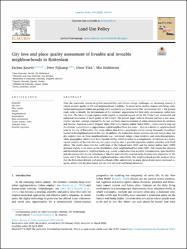City love and place quality assessment of liveable and loveable neighbourhoods in Rotterdam
Abstract
After the worldwide interest in global sustainability and climate change challenges, an increasing concern is
voiced on local quality of life and neighbourhood liveability. In recent urban studies, human well-being, satisfaction and happiness studies are gaining much popularity in a local context (the ‘microcosmic city’). The present
study seeks to identify the determinants of the residents’ appreciation for their daily environment, called here
‘city love’. The latter concept captures both tangible or material aspects of city life (‘body’) and immaterial and
emotional dimensions of local quality of life (‘soul’). The present paper seeks to develop and test a new quantitative ‘city love’ concept, inspired by the soul and body conceptualisation of urban attractiveness for residents
and visitors – based on a novel ‘feelgood’ index (FGI) and a ‘human habitat’ index (HHI) –, with a view to map out
the citizens’ contentment or appreciation (called neighbourhood love index – NLI) at a district or neighbourhood
scale in the city of Rotterdam. Our study utilises data from a quantitative survey among thousands of residents
located in 63 neighbourhoods in this city. In addition, the Rotterdam dataset contains not only survey data, but
also register data on these neighbourhoods, e.g., real-estate values, crime statistics, and socio-demographics,
while geographical information from OpenStreetMap (OSM) is added as a complement. In addition to a multivariate analysis of the rich data set, the paper employs also a quantile regression analysis extended with fixed
effects. The results show that the coefficients of the feelgood index (FGI) and the human habitat index (HHI)
decrease slightly as we move up the distribution of the neighbourhood love index (NLI). This means that physical
and functional aspects of neighbourhoods, e.g., access to such amenities as public transportation, sport facilities,
and also streets with diverse attractions or bikeable and walkable road networks, become more important for the
lower end of the distribution of the neighbourhood love index (NLI). Our neighbourhood-specific analyses show
that the Rotterdam districts and neighbourhoods differ substantially in many physical and social-emotional respects, which calls for place-based policies and sub-local well-being initiatives.


















